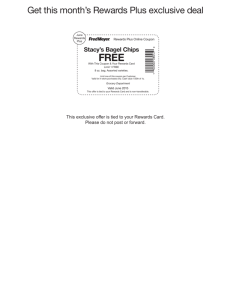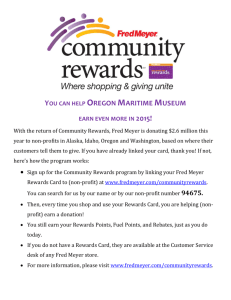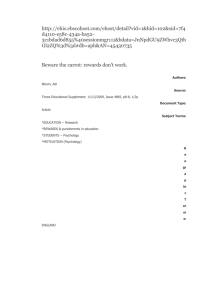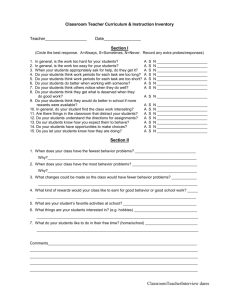Healthy Non-Food Rewards - School Nutrition and Fitness
advertisement
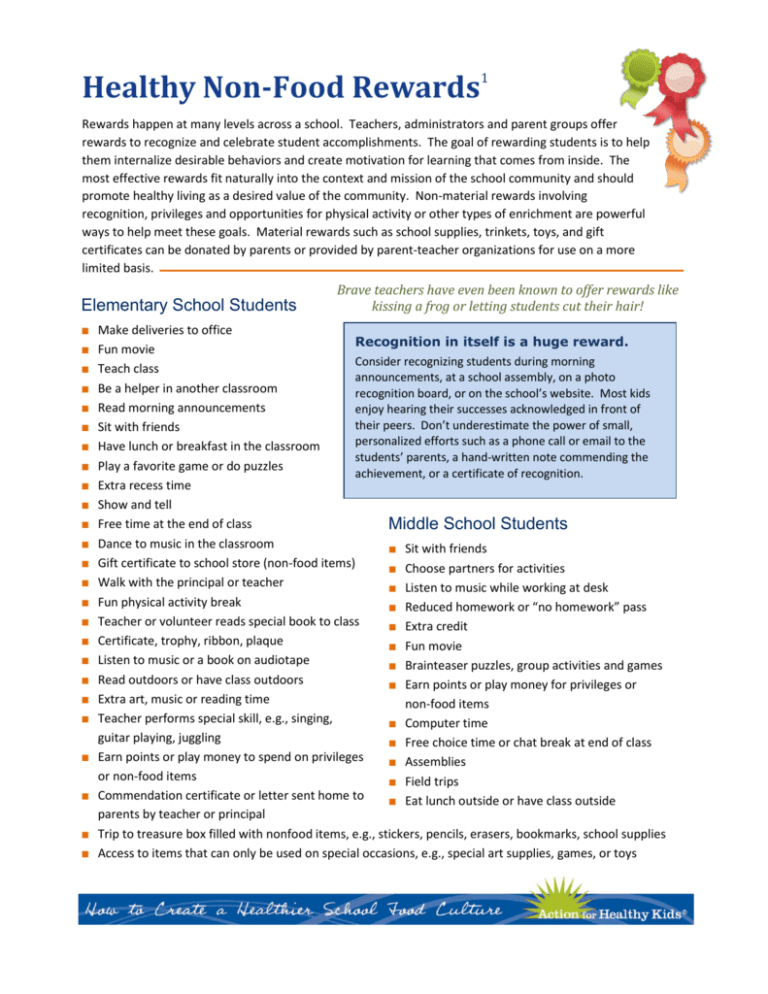
Healthy Non-Food Rewards1 Rewards happen at many levels across a school. Teachers, administrators and parent groups offer rewards to recognize and celebrate student accomplishments. The goal of rewarding students is to help them internalize desirable behaviors and create motivation for learning that comes from inside. The most effective rewards fit naturally into the context and mission of the school community and should promote healthy living as a desired value of the community. Non-material rewards involving recognition, privileges and opportunities for physical activity or other types of enrichment are powerful ways to help meet these goals. Material rewards such as school supplies, trinkets, toys, and gift certificates can be donated by parents or provided by parent-teacher organizations for use on a more limited basis. Elementary School Students ■ ■ ■ ■ ■ ■ ■ ■ ■ ■ ■ ■ ■ ■ ■ ■ ■ ■ ■ ■ ■ ■ ■ ■ ■ Brave teachers have even been known to offer rewards like kissing a frog or letting students cut their hair! Make deliveries to office Recognition in itself is a huge reward. Fun movie Consider recognizing students during morning Teach class announcements, at a school assembly, on a photo Be a helper in another classroom recognition board, or on the school’s website. Most kids Read morning announcements enjoy hearing their successes acknowledged in front of their peers. Don’t underestimate the power of small, Sit with friends personalized efforts such as a phone call or email to the Have lunch or breakfast in the classroom students’ parents, a hand-written note commending the Play a favorite game or do puzzles achievement, or a certificate of recognition. Extra recess time Show and tell Free time at the end of class Middle School Students Dance to music in the classroom ■ Sit with friends Gift certificate to school store (non-food items) ■ Choose partners for activities Walk with the principal or teacher ■ Listen to music while working at desk Fun physical activity break ■ Reduced homework or “no homework” pass Teacher or volunteer reads special book to class ■ Extra credit Certificate, trophy, ribbon, plaque ■ Fun movie Listen to music or a book on audiotape ■ Brainteaser puzzles, group activities and games Read outdoors or have class outdoors ■ Earn points or play money for privileges or Extra art, music or reading time non-food items Teacher performs special skill, e.g., singing, ■ Computer time guitar playing, juggling ■ Free choice time or chat break at end of class Earn points or play money to spend on privileges ■ Assemblies or non-food items ■ Field trips Commendation certificate or letter sent home to ■ Eat lunch outside or have class outside parents by teacher or principal Trip to treasure box filled with nonfood items, e.g., stickers, pencils, erasers, bookmarks, school supplies Access to items that can only be used on special occasions, e.g., special art supplies, games, or toys Healthy Non-Food Rewards Food Rewards High School Students ■ ■ ■ ■ ■ Extra credit Fun movie Reduced homework Late homework pass Donated coupons for music, movies or books Drawings for donated prizes Pep rally Recognition on morning announcements Tickets to school events, e.g., dances, sporting events ■ ■ ■ ■ PTO/PTA Rewards Food Rewards contradict classroom lessons on nutrition, add empty calories to kids’ diets and teach kids to eat when they’re not hungry – setting the stage for unhealthy habits that can last a lifetime and contributing to the childhood obesity epidemic sweeping the country. One study found that every separate food-­‐related practice (e.g., a food incentive or reward) that promotes low-­‐nutrition foods in a school is associated with a 10% increase in students’ body mass indexes (BMI).2 Check your school’s wellness policy or school improvement plan to see if they contain any guidelines or goals about healthy, nonfood rewards. If they don’t, find out what it would take to address this topic. ■ ■ ■ ■ ■ Water bottles School-branded apparel Movie passes Special time with a teacher Dance Dance Revolution, Wii or video game party ■ Pool party, hike, or group trip to a kids’ fun place ■ Raffle for bigger prizes, such as a bike, an iPod or a ride in a limo “Rewarding children with unhealthy foods in school undermines our efforts to teach them about good nutrition. It’s like teaching children a lesson on the importance of not smoking, and then handing out ashtrays and lighters to the kids who did the best job listening.” 3 ─ Marlene Schwartz, PhD, Co-Director Rudd Center for Food Policy and Obesity, Yale University Action for Healthy Kids® partners with teachers, students, parents, school wellness experts and more to fight childhood obesity, undernourishment and physical inactivity by helping schools become healthier places so kids can live healthier lives. Our programs, tools and resources make it possible for everyone to play their part in ending the nation’s childhood obesity epidemic. www.ActionforHealthyKids.org 1 The websites listed in this document are provided as a service only to identify potentially useful ideas and resources for creating healthier school cultures. Action for Healthy Kids is not responsible for maintaining these external websites, nor does the listing of these sites constitute or imply endorsement of their content. Adapted from “Effective and Healthy Rewards for Kids,” Coalition on Children and Weight San Diego and “Alternatives to Food Rewards,” Connecticut State Department of Education, May 2005 (Revised November 2011). 2 Kubik M., Lytle L., Story M. “Schoolwide Food Practices Are Associated with Body Mass Index in Middle School Students.” Archives of Pediatric and Adolescent Medicine, 2005, vol. 159, pp. 1111-­‐1114. 3 “Alternatives to Food Rewards,” Connecticut State Department of Education, May 2005 (Revised November 2011).
